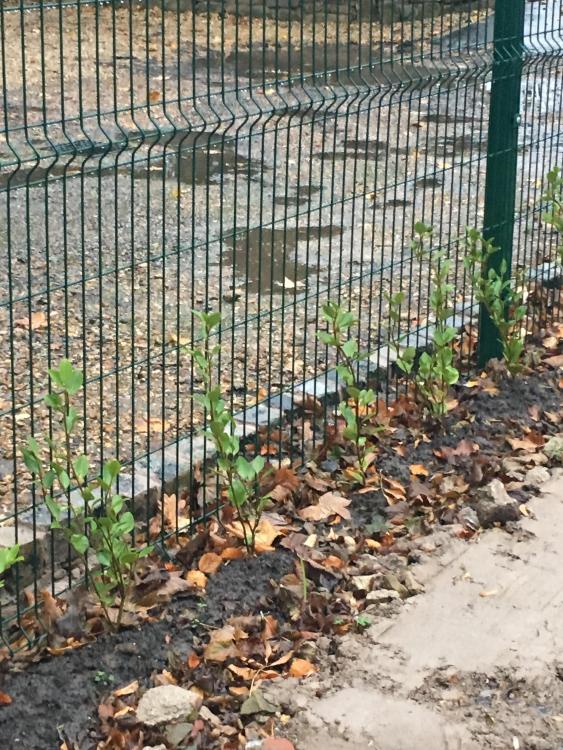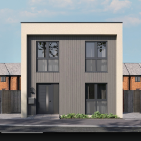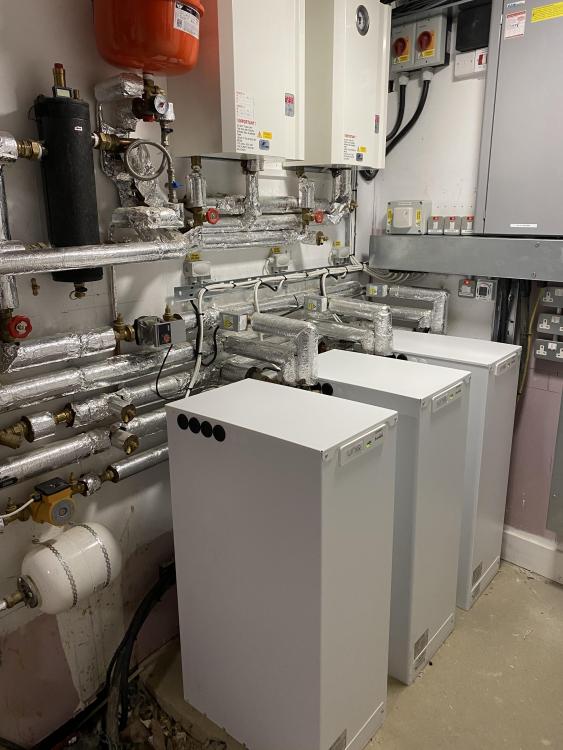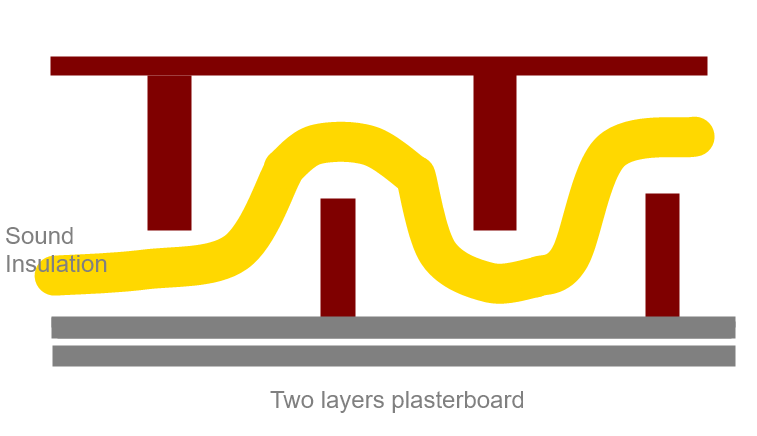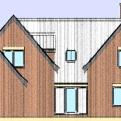Leaderboard
Popular Content
Showing content with the highest reputation on 02/10/21 in all areas
-
150mm minimum. Any less, get radiators fitted. No point heating the mud under the house up.2 points
-
The AECB are having another airtightness webinar tomorrow. https://zoom.us/webinar/register/WN_MBqttYnORDyuaE4vyZN-NQ2 points
-
Exactly. Could I suggest you do your research before you talk to the architect. Unless yours is a planning specialist (as opposed to an ' educated artist ' - as some on here would have it ) . He'll be up for the challenge on your purse. If you research thoroughly first, the challenge to your purse could well be smaller. Innit?2 points
-
It is not just the insulation levels that affect building performance. Weather makes the biggest difference. My weather in West Cornwall is very different from East Kent. The Met Office has good data on this.2 points
-
Now that the main part of our house is finished, I sat down and added up the build cost, excluding land cost, design, planning legal and professional fees. Total cost £141K House floor area 147 square metres So that's a cost of £959 per square metre. Well chuffed to just get in under £1k /m2 That is just the main part of the house. The sun room is yet to be completed (though that cost above does include the shell and the roof of the sun room) and there is still outside work to complete like decking, driveway to finish etc.1 point
-
it can be nailed according to nhbc but as you find they blow when the timber moves, screws not so much. https://nhbc-standards.co.uk/9-finishes/9-2-wall-and-ceiling-finishes/9-2-4-dry-lining/1 point
-
With spectacular timing, our window order went in too late to beat the summer factory close down, resulting in a 4 week delay on top of the normal 6 - 8 week delivery time. Better late than never, our windows arrived a fortnight ago, all the way from Poland. Having a passionate hatred of UPVC windows, we specified 3G aluminium clad timber windows. I obtained a few quotes from different manufacturers / suppliers, but in the end, after pushing hard on price, we went with Rationel, (supplied in Scotland via ADW Ltd). Without seeing them in person, it is difficult to appreciate the quality of the windows, but we are absolutely delighted. They appear very well made, so much so that all of the joiners working on our build have so commented, and my builder has switched to Rationel as his supplier of choice. Performance wise, we have a combination of 4-20-4-20-4 and 4-20-4-18-6 triple glazed windows, with U values ranging between 0.7 and 0.9 depending on the size of window and an overall project U value of 0.8. Price wise, including the extra delivery costs relating to our location, we've paid £290 per sq metre for our windows and doors. Fitting the windows took a couple of days. Whilst the majority of the openings in the ICF blockwork had remained true, one or two were slightly out which meant the odd packer here and there to ensure the windows were level and plumb. The windows have all been positioned such that they protrude 20mm beyond the outer face of the ICF block: : and are secured in place internally be metal straps fixed to the window frame and the timber openings: The standard Rationel installation detail is a little odd (as has been experienced by ProDave) in that they want a gap left between the edge of the alu cladding and the window reveal / ingo, so as not to block the drainage channel that forms part of the alu cladding. We deviated from this detail, primarily because neither I nor my builder had any confidence in it. We were both of the view that if left exposed, such a seal was bound to fail within a relatively short period. In fairness, Rationel do say that it is up to the installer to fit the window to suit local conditions. http://www.rationel.co.uk/media/1614084/Installation-Drawings-ALDUS.pdf Rather than using expanding mastic tape (compriband) we are using a Soudal sealant to seal the timber window frame to the timber opening. External insulation is then brought hard up to to the aluminium window cladding. This keeps the drainage channel on the alu cladding open but completely conceals the main line of sealant behind. The window reveals / ingos will be finished with render or timber clad hard up to the alu cladding. In the case of render, a stop bead will be used at the alu cladding junction to ensure a good finish and an effective seal. The window cill which you can see pictured above was sourced independently of Rationel / ADW Ltd. For reasons I cannot quite fathom, Rationel do not supply cills. This is the responsibility of their agents who in the case of ADW Ltd source them and have them painted to match the windows here in the UK. Unfortunately, they were unable to supply me with cills deep enough for me needs, so I had them fabricated and painted by a company in Glasgow - MSP Scotland Ltd. I paid just under £250 for all my cills. Again, we are delighted with the quality - 2mm folded cills, which fit snugly into the preformed cill groove on the underside of the Rationel windows. Two depths of wall insulation have been fitted to our house, 100mm to the section to be timber clad, and 140mm to the section to be rendered. The main reason for restricting extra insulation on the timber clad section to 100mm, was to facilitate the subsequent fixing of battens to carry the timber cladding. To facilitate precision cutting of insulation, a hot wire cutter was used: The external insulation was fixed using a combination of expanding foam and mechanical fixings. Foam was applied to the back of the insulation sheets which were then positioned on the wall. Mechanical fixings (pictured below) were then used to firmly secure the sheets, in the case of the timber clad section (100mm insulation), the long screw and black washer which fixes into the plastic ICF block formers in the core of the block, and in the case of the rendered section (140mm insulation) a plastic type plug drilled into the concrete core of the block. The insulation itself came in different sizes. The 100mm insulation was supplied in interlocking 1200 x 600 mm sheets. The 140mm insulation came in 2400 x 1200mm sheets. Opinion on site was split between the pros and cons of each size with advantages and disadvantages to both. Fewer joins when using bigger sheets, but smaller interlocking sheets were easier to work with. A couple of pictures of how it now looks: All being well, the scaffolding should be removed shortly, ready for the render system to be applied. The joiners have started fitting battens to the section to be timber clad so it's all systems go.1 point
-
100mm panels were Amvic supplied. It was a 150mm stainless screw and black plastic 'washer' that was used to fix them to ICF block webs, as pictured above.1 point
-
Keep your chin up. I think just about everyone has a wobble of some sort part way through a self build when not everything goes to plan. Take a break, then go back to it with a fresh mind. Plenty have come up against serious problems and beaten them. You will too.1 point
-
1 point
-
Where are the normal plots? I've been looking for a plot for a self-build for over a year! PlotFinder/PlotBrowser/RightToBuildRgister etc Anywhere in the South East South West is £200k+ which at Graven Hill gets you a full serviced plot and planning. I'm looking into GH right now and think it's not a bad option especially as you get creative freedom with the aesthetics of your home and don't have to do a pastiche of some hideous 1930s Semi.. Happy to hear where I should be looking to get something for £100k! Thanks1 point
-
1 point
-
ICF Wall thickness is 440 if you go for the woodcrete type to get to 0.12 and 375 for EPS type and this achieves 0.11. Planners have forced me to use multiple finishes externally - Brick, Stone, Timber and render all of which can go directly onto the ICF wall surface so no need to batten etc. which also saves time.1 point
-
@joe90 That was my concern and as I live under a rock I’d never heard of those thread sealing gloops, looks like that is the way ahead.1 point
-
Yup. In the plant rooms / exposed areas ( like one of my previous installs above ) I always change to something solid, but behind the scenes I run Hep everywhere else. The benefit of not having hidden joints in the fabric of the dwelling is good enough reason for me to mix the disciplines accordingly.1 point
-
Make sure that your window opening dimensions for your windows are made with the window "boxes" installed. I actually did all of mine from the timber-frame drawings and it was check check, check again with me coordinating (and taking responsibility) with MBC AND the window supplier to ensure installation tolerances were correct and the windows could be installed.1 point
-
1 point
-
I don't think Ground Source HP offer many advantages over Air Source. Air Source is far more widely used so will probably be a much better bet in terms of future availability and innovation. Heat pumps are zero carbon, subject to electricity generation method. LPG is a pain and I would not recommend. You are held to ransom by the suppliers. It is expensive and emits CO2. Solar thermal seems a waste of time compared with solar PV, which is getting better all the time. PV is zero carbon. Woodburner is toxic and polluting and expensive if you don't have a free supply of wood.1 point
-
Bin the thin joint if you want fast (as I have said before) Are you sure that is the wall figure or the weighted wall figure when including the windows...??1 point
-
@WWilts, Dritherm Cavity slabs are rated for 'full fill'. Silver/Graphite/Grey bonded EPS bead, conductivity 0.033/0.032W/mK with any block with a thermal resistance less/equal to 0.18W/m.K would get to your U-value. i.e. 100mm block/100mm bonded bead/100mm block. It could possibly be top filled.1 point
-
https://www.screwfix.com/p/flomasta-pipe-thread-seal-50g/4373j or this stuff. It doesn’t even need doing up tight as once it goes off has a good mechanical strength1 point
-
Thanks @Thorfun Your project looks interesting and definitely bolder than mine! Like you say principles are similar, my intention was to look at getting quotes from at least 4 national operators and 3 more localised suppliers. I was looking for some recommendations based on my criteria, Flight Timber are definitely one to add to the list based on your experience. Thanks for the advice ?1 point
-
I’ve said it before and I will say it again. Do people get hung up on the u value of an element, when it’s all about good details and getting the whole construction right. My icf block walls come out at 0.22, yet I think as a whole structure the house is excellent. Good walls, good roof, good floor, good windows, good air tightness, and a brilliant builder turns into an excellent house.1 point
-
http://vesma.com/tutorial/uvalue01/uvalue01.htm https://www.ubakus.com/en/r-value-calculator/?&lang=en Have a play.1 point
-
1 point
-
Thanks, it will be softwood of some kind. Rest of the wall are clad with siberian larch, hmmm, maybe the fascia etc ought to be too. Duh!1 point
-
1 point
-
Yes Siematic is a good product, albeit a bit pricey. But it will easily last you 25-30 years and will still look good as new with a bit of TLC1 point
-
Preventing air leaks through the blocks below the slab. These won't be wet plastered as they are above the plasterboard in line with the suspended metal ceiling. Also painting the top of the blocks guarantees a continuous unbroken airtightness line to the poured concrete.1 point
-
From what I've read building two separate walls/floors that aren't connected and both have mass is the way to go. Anything that connects one side to the other is a potential transmission route. This sort of thing... PS: My son has just started a degree in Acoustical Engineering so ask again in three years and he might tell me its all wrong ?1 point
-
Get yourself a Pharos WiFi Access point, circa £90 for a pair. Use one at the house with the internet connection and point to the cabins where the other one is situated. https://www.broadbandbuyer.com/products/19209-tp-link-cpe510kit/ Our village uses them for community broadband (effectively Wi-Max). I additionally use one to light up my garden, if I point in the the right direction, I can get wifi about 4-6km away.1 point
-
Cat cable is only 100m . Buy far thr most easy and reliable is just a directional Point to point . Cable into one , cable out the the other into local WiFi/router box in your cabin . Something like https://www.broadbandbuyer.com/products/28800-ubiquiti-nbe-5ac-gen2-pnp/?gclid=Cj0KCQiAgomBBhDXARIsAFNyUqMWx9hcfz54HsuA_-ZHNyW0IMg4pKw7mFRe5JDvhuA7YSqFF5pYbPAaApRMEALw_wcB Guide here https://wifigear.co.uk/blog/linking-buildings-point-to-point-wireless-guide/ just to say ; regarding the internet connection the main house we decided to just use a data Sim and directions antenna roughly pointing to the nearest tower (as we only had 2-3 bars on my phone). It’s great at 80MBs in both directions and reliable.1 point
-
Please see the link below relating to windows produced by Velux between 1997 - 2003 and relates to spontaneous failure of the glazing units. https://velux-pw.velux.co.uk/?_ga=2.166737595.447046536.1560509373-1221441066.1560350180&_ga=2.166737595.447046536.1560509373-1221441066.15603501801 point
-
I'm on totally the other side of things - I hate lawns with only one species of grass in them, no wildflowers, etc. Mowing will kill off anything that can't survive being in a lawn (grasses grow from the base, most other plants grow from the tip - so if they're not low-growing mowing will take them out), and then over-seed with a lawn seed mix to deal with gaps. You end up with a slightly patchy effect, but it's a much more diverse and wildlife-friendly zone.1 point
-
Phone them and talk to them, don’t read the website. I am finding that 90% of the companies I buy from don’t actually know what they are talking about or understand what they sell. I had to tell them constantly that ivar make a lower temp blending set, they had no idea and didn’t know why I would want one. The problem is the people that work at these places live in a Barrett house and are just happy someone is stupid enough to pay them every week.1 point
-
If you want more detail and some history get an emonPi from the open energy crew in Wales - great kit. You can set up as many dashboards as you want and also measure temperatures. https://shop.openenergymonitor.com/emonpi/ I should add I'm nothing to do with them, except from being a member of the forum there. It's all open source, so we set up our own system on a spare Rasp Pi and also built a Solar PV diverter following guides. There's a huge amount of info on the forum. Simon1 point
-
No it is the house we want rather than a budget house. Decent levels of insulation, Rationel triple glazed windows, Oak flooring doors, door frames and skirtings, and not cheap doors. Granite worktops, both bathrooms as wet rooms. But everything was priced and sourced carefully, e.g. Internorm windows would have been twice the price or Ratioel.1 point
-
We also bought Siematic after having one before. Yes they are expensive but they last for years and are top quality. You get what you pay for and in our case we decided to go Siematic again.1 point
-
I have to confess we went with a Siematic kitchen. Even though it cost maybe a 1/3 more than a good quality UK supplied one, you can see the difference. The most obvious ones are the cupboards have a noise seal along the entire perimeter of the carcass, the shelf supports are very robust (I think I could probably stand on them) and the doors have fittings to take a range of accessories (which are eye-wateringly expensive). Having a good fitter also helped. We didn't buy it to make the house easier to sell though. 3 years on, it still looks like new, despite the best efforts of our grandson. ☺️1 point
-
In ‘normal’ Planning terms, I would say that’d be classed as a front/infill extension as you’re increasing the habitable floor space. Under PD, I would therefore say infilling that space would count towards your PD limit. You have already provided a porch over an external door and if it already measures 3sq.m, anything more would require Planning.1 point
-
This worked out really well! Found someone who's selling direct and got a massive discount on delivery... thanks!1 point
-
0 points
-
0 points
-
Yes, between 2 and 3 litres a day, imagine that as a puddle in your living room. It would dry up faster if it was warmed up nicely and allowed to ventilate out the house. Oh, hang on, Page 10 points
-
It is snowing in Bude as well but @joe90has not noticed because his wife is chasing him around the houses demanding to know why he opened the bi-fold doors to let in an arctic blast of 27 Fahrenheit air.0 points
-
You need to say what type of shower tray / wet room former is going in If it’s a pre-cast above floor tray it’s minimal effort, but you need to shutter out for a wet room type former etc. Impey and Diamond are a couple I’ve fitted, and only need 22-25mm installation depth. Stick to your guns, it’s a great idea and makes a room look a million dollars. He’s secretly enjoying0 points
-
0 points
-
join the club!! . @SteamyTea will be along in a mo with a bar chart/graph to show what your savings will be! And your pay back time. I worked on the assumption that even if I have to use electric heaters for the few weeks a year to keep warm when it’s really cold (like now) it’s worth it. I ain’t going to live long enough for some pay backs ?. saying that, I am sat in my solar heater (south facing conservatory), temp up to 27’, bifolds into the house open so heating the house for free ?0 points
-
so, after my 3rd web-chat with them over the last 2 months today, and after sending everything I have information wise stopping just short of paternal grandmothers inside leg measurement and blood group of her next door neighbours cat, I'm finally fobbed off yet again saying that i need to pass the Experian part of the application!!! WTAF !!!!! Having a full hours break from work I decided to give them a call at the same time as being on the web chat and play one off against the other, furious as to why after submitting all I have after the xmas eve email and being told on 3 occasions since 'no its fine we have all we need, just sit tight your application is being processed. Apparently their 'SOPHISTICATED' system tells them when cases need further information. which is all well and good but its not that SOPHISTICATED that it tells the applicant. spoke to a very helpful person (unless they were just grand masters of the fob off and I've been had again) who stated that I needed to send in further information, after telling them thats what i did after the xmas eve email they then looked further into it, and proclaimed, 'oh i see', i'll send it on to the next stage then for audit team !!!! I asked the question why has it taken 3 web chats and a call to progress to the audit team, when this could have been done in early Jan after I'd sent all of the information in. to which i simply got the reply. 'i can understand your frustration' the word farce doesn't even do it justice And as for SOPHISTICATED system, i asked the GHG agent to look up the word oxymoron0 points
This leaderboard is set to London/GMT+01:00





